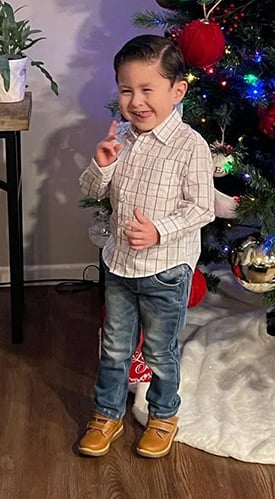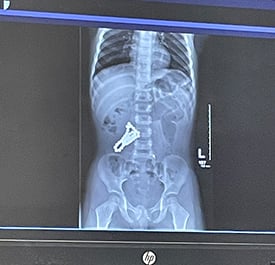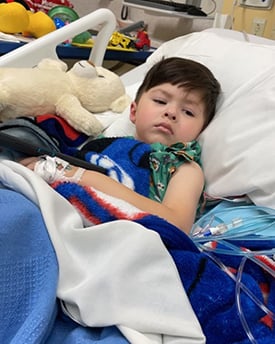Swallowed Magnets: Elijah's Story
Meet Elijah

Elijah is an energetic three-year-old who lives with his mom, Jenna, in Topeka, Kan. He loves having his picture taken and running really, really fast.
“He’s always been active,” said Jenna. “He doesn’t want to miss anything. He wants to see all of it all at the same time. Even when we’re reading a book together, he’s trying to read the next three.”
You could say Elijah has always been a little on the impatient side: He was a preemie baby, born at 34 weeks. He’s been keeping Jenna on her toes ever since.
That’s how she knew something was wrong one Saturday in June. Elijah is usually an early riser, but that morning he slept in late and had no interest in playing.
Not a stomach bug
“He didn't want to talk,” Jenna remembered. “He didn't want to get up. He didn't want anybody to even look at him.”
Later that day, Elijah began throwing up. Concerned, Jenna brought him to a local emergency room (ER) where she was told he had a stomach bug. After being sent home, his vomiting lasted for three more days. But then it stopped, and Elijah seemed like his rambunctious self again.
Several weeks later, the symptoms returned.
“It started all over,” Jenna remembered. But this time, Elijah couldn’t even keep down water. “My concern at that point was he's dehydrated, so we took him to the ER again.”
There, Elijah managed to drink some juice and take anti-nausea medication.
“Then they sent us home again. We weren't even fully through the door, and he just throws all of it up,” Jenna said. She called the ER back.
“They told me if they sent him home, then he should be good,” Jenna recounted. “So I was like, OK, if you're telling me it's fine, then I guess it's fine. So, again, we just waited it out.”
After a few more days, Elijah did seem fine. His symptoms stopped, and he regained his energy. But three weeks later: déja vu.
Jenna, who works construction in the morning and serves in a restaurant at night, had just gotten home. Her mom had been watching Elijah and gave Jenna the bad news: He was throwing up again.
They went back to the ER.
“Around 1:30 a.m. [the ER doctor] goes, ‘You know it’s a stomach bug. You guys can go home. Give him some Pedialyte.’ That’s when I just snapped,” Jenna remembered. She had been working since 5 a.m. She was only hours away from needing to go back to work with no sleep and no answers.
“I had just had enough at that point. I was like, you need to give me a better answer than ‘it’s a stomach bug,’” Jenna said. The doctor agreed to do an X-ray “for her peace of mind.”
When the X-ray came back, it showed a string of round objects, like a beaded bracelet or necklace, lodged in Elijah’s gut. Jenna thought they looked similar to toy magnets she had seen a family member playing with at the park — they seemed to be the same size and shape. The ER rushed to transfer Elijah by ambulance to Children’s Mercy Kansas City.

Elijah and Jenna arrived at Children’s Mercy around 3:30 a.m. The team in the emergency area leapt into action as they tried to assess the best course of care.
Jenna made sure the doctors knew Elijah might have swallowed magnets. Doctors couldn’t perform certain diagnostic tests, like MRIs, if magnets were a possibility. They would have no way of knowing what Elijah had swallowed without surgery — surgery he needed as soon as possible.
Just hours after admission, Elijah went into surgery, and Jenna waited anxiously for news. Almost six hours later, Elijah woke up in the ICU with a very relieved mom at his side. The surgeons had removed 37 tiny magnets from his intestines and fixed the extensive damage caused.
Unfortunately, not uncommon
Thomas Attard, MD, pediatric gastroenterologist and Director of Endoscopy Services at Children’s Mercy, explained that there is a very small window of time to retrieve swallowed magnets without surgery. It may take as little as 15 to 20 minutes for objects to move beyond the stomach, where they could be retrieved via endoscopy and may need open surgery. Sometimes patients will miss the endoscopic window, but the magnets clump together, move through the intestines and are expelled naturally.
As in Elijah’s case, things get complicated when magnets get stuck somewhere in the digestive tract — especially if they attract each other and stick together. Dr. Attard said that multiple magnets are some of the most dangerous things kids can swallow, along with button batteries, detergent pods and sharp objects.

“The worst is when a kid is eating small magnets like M&M’s and popping one after another one,” Dr. Attard said. “Then there’s a string of magnets moving through their digestive system. When those really strong magnets meet back up, they pinch the bowel in between. The bowel is very thin in parts, only 2 to 4 millimeters, so those magnets create holes.”
Those tears can either create a leak into the abdomen, resulting in peritonitis, a serious infection that can be life-threatening, or can make a kind of shortcut between different parts of the intestine, where waste bypasses large sections instead of going through the normal digestion process. This can cause diarrhea, abdominal pain, bleeding and nausea.
In all cases, getting medical attention as soon as possible is key. “Most cases will pass through,” said Dr. Attard, “but if you witness a child swallowing a magnet, you should go to the ER right away. If the magnets don’t pass, it can be really catastrophic.”
A full recovery

Of course, kids are sneaky. Most of the time, no one sees the inciting incident, just the confusing symptoms. Jenna was relieved to know what had caused Elijah’s ongoing pain and nausea. She was also glad she pushed to get a diagnosis during that third, hard, late night in the ER. She encourages other parents to do the same.
“You know your kid,” Jenna said. “You know when something is wrong. Trust your gut. I wish I had pushed even earlier.”
She was grateful to Children’s Mercy for listening to her and helping Elijah. “I can never thank them enough for everything they did for him,” she said. “They were really patient and understanding with him. It’s definitely the place you want to take your child if you’re ever in a situation like ours.”
After a week of recovery, Elijah was cleared to go home. With the help of Children's Mercy, Elijah’s everyday enthusiasm returned.
“The moment he got home, he was taking all his toys out,” Jenna laughed. “He was ready to do everything he was doing before.”
Magnets are not toys
Please, please don’t buy magnets as toys.
Rare-earth magnet sets have become popular in the past decade, even as poison control centers reported a spike in magnet ingestion cases. The U.S. Consumer Product Safety Commission recalled both Zen Magnets and Neoballs in August 2021, and continues to warn families about their dangers.
If you think a child has swallowed a magnet:
-
Go to the ER.
-
Don’t let the child eat any food (in case anesthesia is needed for treatment).
-
Tell doctors magnet ingestion is a possibility.
-
Insist on observation and X-rays to confirm and monitor movement.
Rumination disorder: Austin's story
Austin is a kid who loves creative activities - many of which help him manage his rumination syndrome. Through a multidisciplinary approach, the Rumination Disorder Clinic has helped Austin find techniques to help with his body's involuntary response to swallowing food.

- Gastroenterology
- Celiac Disease
- Constipation and Encopresis
- Feeding Clinic
- GI Procedures: What to Expect
- Inflammatory Bowel Disease
- Intestinal Rehabilitation Program
- Liver Transplant
- Pediatric Abdominal Pain Program
- Pediatric Gastroenterology Fellowship
- Pediatric Motility
- Rumination Disorder Clinic
- Meet the Team
Section Chief, Pediatric Gastroenterology, Gastroenterology, Hepatology & Nutrition; Director, Gastrointestinal Endoscopy Services, Gastroenterology, Hepatology & Nutrition; Medical Director, Polyposis Clinic, Gastroenterology, Hepatology & Nutrition; Professor of Pediatrics, University of Missouri-Kansas City School of Medicine; Clinical Professor of Pediatrics, University of Kansas School of Medicine